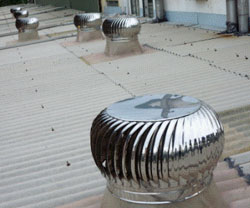Industrial Loft Ventilation
Proper ventilation is crucial for keeping workers safe in industrial settings. While it’s great for a building owner to make ventilation a priority, it’s important that they do so with all applicable regulations and guidelines in mind. By properly ventilating an industrial loft, potentially harmful vapors will be removed from this area and other parts of the building.
Can’t Workers Just Use Respirators?
There are situations where respirators are the only way for workers to protect themselves. However, most guidelines note that respirators should be used as a last resort instead of a primary means of giving workers a clean supply of air. Before resorting to this method, one or more methods of industrial ventilation should be implemented. This type of ventilation has three primary goals. They are:
- Keeping oxygen levels above twenty percent
- Minimizing the amount of flammable vapor in the air
- Reducing indoor air’s fume, dust and chemical levels
There are three types of ventilation that can be used in industrial lofts and other areas of this type of building. They are local exhaust ventilation, dilution ventilation and indoor air quality ventilation. The goal of local exhaust ventilation is to stop emissions before they are able to spread from the source of their origin. Once they are caught by a ventilation mechanism, they are expelled outside.
How Does Local Exhaust Ventilation Compare to Dilution Ventilation?
Dilution ventilation takes a larger scale approach than local exhaust ventilation. Instead of focusing on a specific area, dilution ventilation blows fresh air throughout an entire industrial loft and the rest of a building. Additionally, it pulls out some of the lower quality air. One reason this option appeals to building owners is because its installation costs are lower those of local exhaust ventilation.
On the other hand, local exhaust ventilation removes more contaminants than dilution ventilation. But because of the specialized nature of the local exhaust method, the dilution method is a better choice for industrial buildings with more general requirements. This option also requires less maintenance work. Because dilution requires more air, local exhaust has lower ongoing costs. Since each method has its own set of pros and cons, the best fit for an industrial building will depend on its specific needs.
What are the Components of a Local Exhaust Ventilation System?
If you decide that the local exhaust method is the best fit for your industrial ventilation needs, there are five components that this system will need to have to provide the best performance possible. The components are an exhaust stack, fan, air cleaner, ducts and a hood. The exhaust stack is where used air will be expelled. The fan will push old air through the exhaust stack. The air cleaner will decontaminate air as it moves through this industrial ventilation system, while ducts can be customized to transport air as far as necessary. And the hood is where air will be pulled into this system and sent through the ventilation process.

Categories
- Home
- Types Of Loft Ventilation
- Attic Ventilation
- Heat Recovery Ventilation
- Industrial Loft Ventilation
- Loft Roof Space Ventilation
- Natural Ventilation
- Pigeon Loft Ventilation
- Positive Pressure Loft Ventilation System
- Proper Roof Ventilation
- Roof Ventilation
- Soffit Loft Ventilation
- Solar Ventilation
- Loft Ventilation Companies
- Loft Ventilation Information
- Loft Ventilation Products
